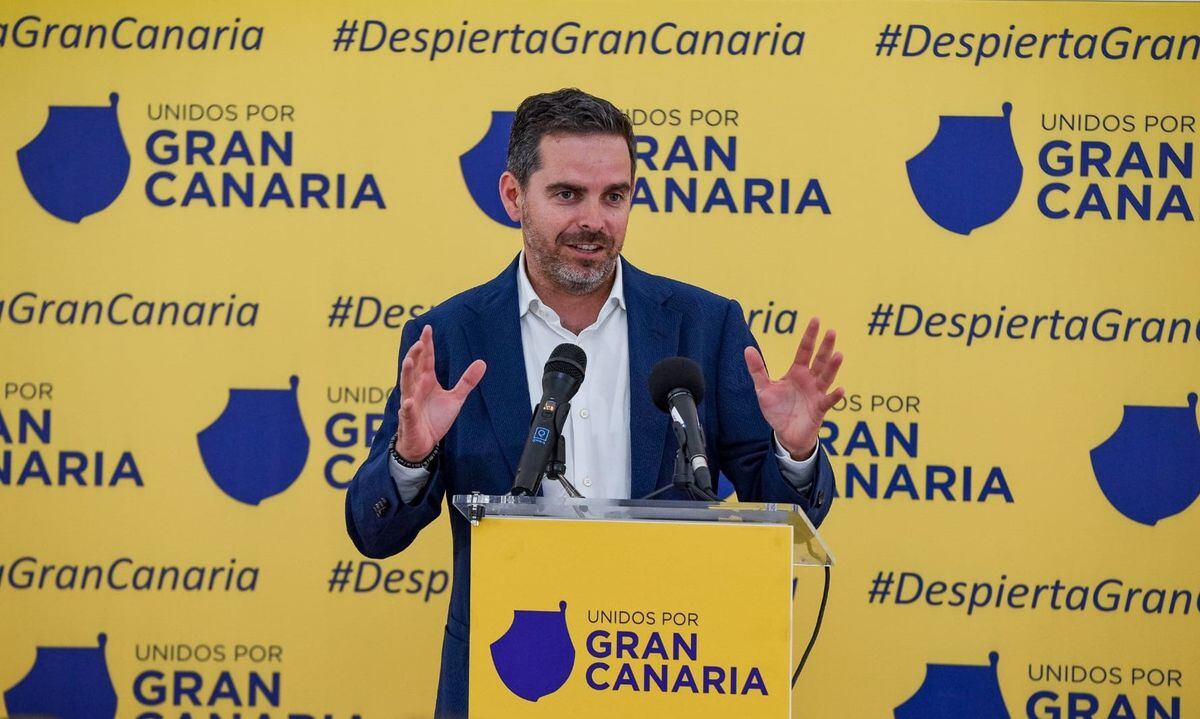The musical director of the murga Los Nietos de Kika, Sergio León, marks the entrance of some thirty men who, carnival whistle in hand, have met tonight at a municipal theater in Arucas (Gran Canaria, 38,400 inhabitants) to take conduct the dress rehearsal before the start of the carnival.
"In this we give President Torres and the
chichas
[by chicharrero, the adjective given to the inhabitants of Santa Cruz de Tenerife and, by extension, those of the entire island]," says Orlando Jiménez, 69 years old, president, proudly. of the formation for 47.
The Nietos de Kika Afilarmónica is the second oldest murga in the archipelago, created in 1976 “in the image and likeness” —a term used by Jiménez— of the dean, NiFú-NiFá from Tenerife (which, in turn, is inspired by the chirigotas from Cádiz), which dates back to the 1950s —a murga is now considered afilarmónica (a term devised by NiFú-NiFá herself in the 1950s when the civil governor prohibited the festival and all terms related to it, such as
murga
) when he wins the contest three consecutive years or five alternate years.
Both the members of the group and the president himself cannot hide the excitement caused by the return of the most important festival of all those celebrated on the islands.
"This year is very special, without a doubt," Jiménez stresses.
"We love carnival more than ever."
This excitement is perceived, in the same way, in the streets of both capitals after a year of suspension —2021— and another at half throttle —that of 2022, which moved to the summer.
Cristina, a waitress at one of the terraces that populate Parque Santa Catalina, the epicenter of the Gran Canaria carnival, a few meters from the main stage of the festivities, explains it perfectly.
“My boy, this year we changed the masks for the little masks [person in disguise with his face covered] and that is good for the spirit and for business,” she asserts with an ironic smile.
The economic issue is not minor: each of the two carnivals has an economic impact of between 35 and 40 million euros, according to figures from the town halls.
But for Canarians it is often about more than just money.
"The essence of carnival is social contact, much more than grand galas," explain sources from the Santa Cruz Town Hall.
“And in few parties there is as much contact for a canary as in the carnival.
That's why the break was so painful for us."
Rehearsal of the murga Afilarmónica Los niitos de Kika, on Friday, February 3 at the Nuevo Teatro Viejo in Arucas.
Carnival in the Canary Islands has its roots in the decades after the Castilian conquest at the end of the 15th century, with the first direct references dating back to the end of the 16th century.
Various historians, such as Israel Campos, from the University of Las Palmas de Gran Canaria, point out that the settlement of merchants of Italian origin constituted the germ of the festivities.
“Carnival at that time was clearly Venetian,” he explains.
In the 19th century, the festival takes a turn with the appearance of private companies that organize parades of the little masks.
Writings from the 18th century have been recovered, continues the historian, in which the bishops ask the population for decorum during the
carnival
.
In 1917, according to sources from the Santa Cruz corporation, a key event took place, with the docking in the port of Santa Cruz of the gunboat
Laya
, with a crew from Cádiz.
This contact constituted the germ of the creation of the murgas, the island translation of the chirigotas of the Andalusian city.
The tradition of electing a queen dates back to the 1930s;
the comparsas, in imitation of the parties of Rio de Janeiro, in the sixties.
The Franco regime first banned the festivities and "tried to baptize them as winter festivities" later.
Without much success on both occasions, recalls Campos.
The best known internationally is the Carnival of Santa Cruz de Tenerife (205,000 inhabitants), which the arrival of democracy brought to the center of the city.
It was declared a Festival of International Tourist Interest in 1980. In 2019, the last year of full normality before the covid, the event brought together more than 400,000 people in the concert that the Dominican Juan Luis Guerra offered in the capital.
This year, the City Council has invested approximately 3.2 million euros in the organization of parties under the New York theme.
The festivities officially began on January 20 in the city.
The murgas final was held on Friday, February 3, with the victory of the Trapaseros in Interpretation.
Its highlights, however, are yet to come: the Gala de la Reina on the 15th, the Daytime Carnival on the 19th, and the Coso, a massive procession of floats that runs along Avenida Anaga to be held on February 21. .
The importance of these festivities for the city has led the government team of José Manuel Bermúdez (Canary Islands Coalition) to propose the groups that participate in the festivities —some 6,000 people— to be awarded the 2023 Canary Islands Award, within the modality of Altruistic and Solidarity Actions.
Carnival in Las Palmas de Gran Canaria (380,000 inhabitants) has experienced an explosion of popularity since the 1990s, although in recent years it has met with resistance from the residents, who are trying to expel it from the city center — "It is perhaps", explains Israel Campos, "a sign that unlike what happens in Cádiz, the local citizens do not end up seeing it as something of their own" -.
It was declared a Festival of National Tourist Interest in 2017, promoted mainly after the implementation since 1998 of the Drag Queen Gala, a pioneer in the world, according to the City Council.
Despite the protests of the residents, Inmaculada Medina, Councilor for Public Services and Carnival, maintains that "it is part of the very identity of Las Palmas de Gran Canaria, an open and cosmopolitan city."
The investment of the government team of the mayor Augusto Hidalgo (PSOE) has recovered the luster of yesteryear, and is between 3.5 and 4 million euros (without counting the contribution of the sponsors).
The key events of the Gran Canaria festivities, which have the theme of the New York disco Studio 54, will be the Gala de la Reina (February 24), the aforementioned Drag Queen Gala (March 3) and the Great Parade throughout the city (March 4).
The Murgas final in Gran Canaria is scheduled for Saturday the 18th. It is for this event that Los Nietos de Kika prepare four songs, as well as the presentation and farewell.
All for the love of art.
"There we have everything," says Orlando Jiménez while he points with his chin towards the stage, where the afilarmónica sings to the Canarian president, Ángel Víctor Torres.
“We have doctors, anesthetists, plumbers... and even two pensioners.
Some arrive stained from the play, but rehearsals are not lost.
Carnival unites us all”.
Subscribe to continue reading
Read without limits
Keep reading
I'm already a subscriber

/cloudfront-eu-central-1.images.arcpublishing.com/prisa/SVUKBSAKVBFI7MTVIZXKG43FXM.jpg)










